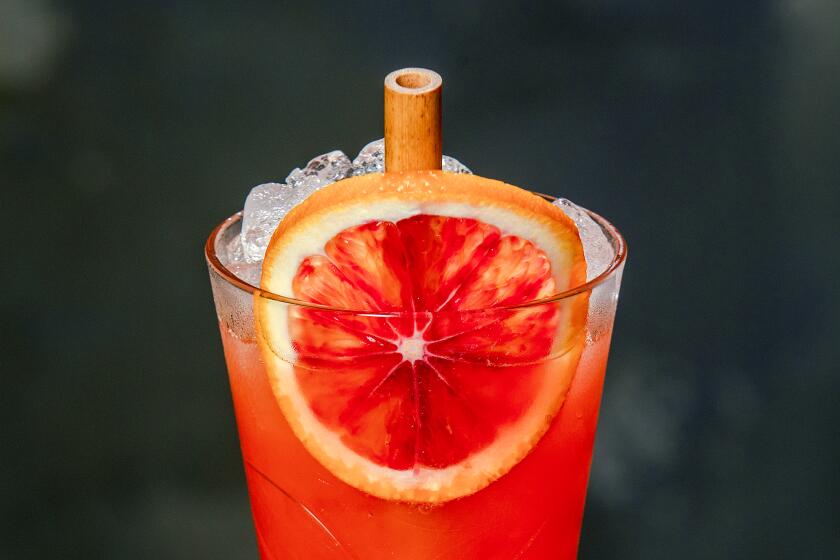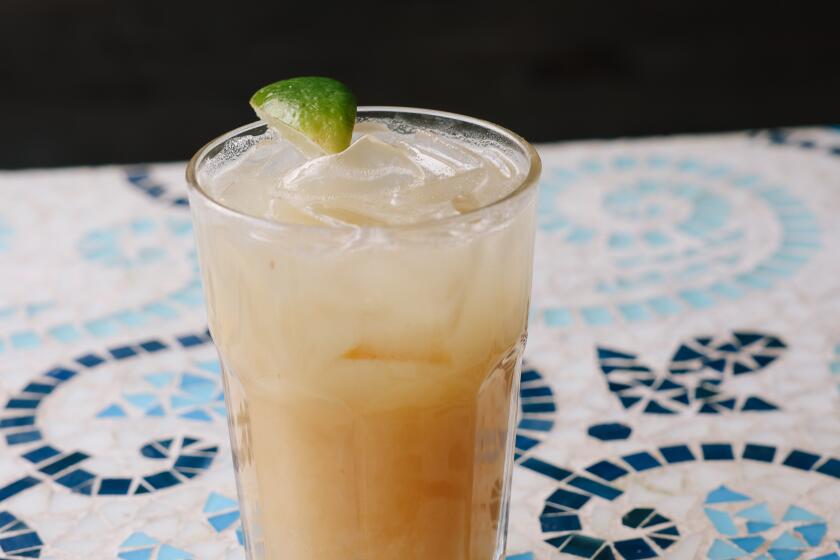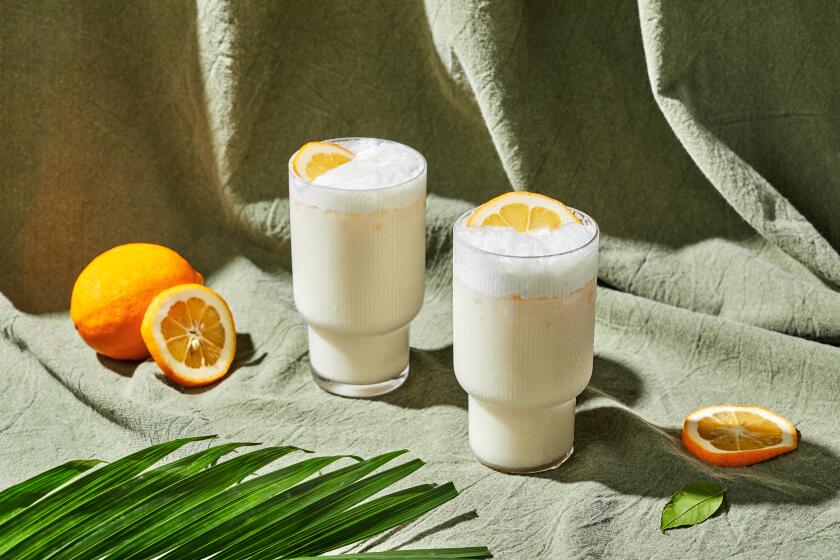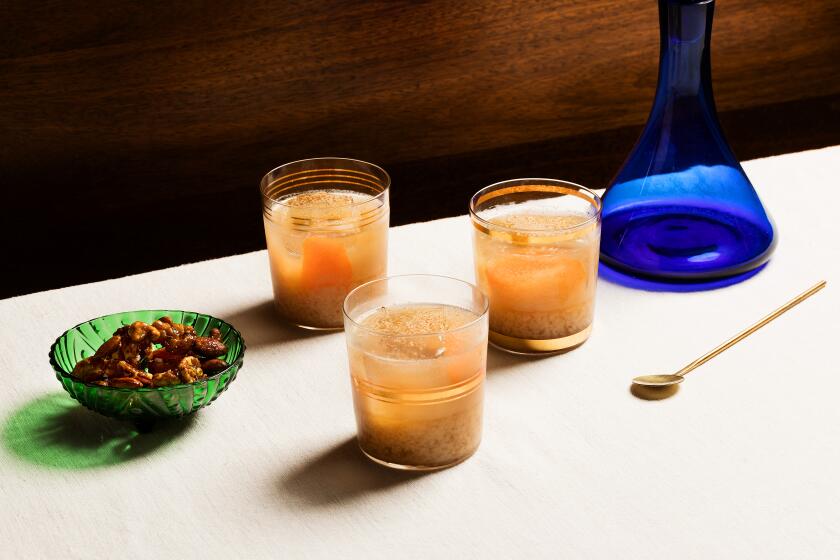Batida de maracuja (passion fruit batida)

FOLLOWING a now-familiar pattern in the spirits world, cachaca, the Brazilian liquor made from sugar cane juice, has made a heady move up the social ladder in recent years. Like those other better-known New World distillates, rum and tequila, cachaca (ka-SHAH-sa) was originally a working man’s drink but has lately been taken to new, more sophisticated heights by ambitious producers.
Although very few of the thousands of cachacas made in Brazil are available in the United States, the drink is catching on here. It’s part of the international fascination with all things Brazilian, and it’s showing up in the U.S. not only at Brazilian restaurants but also at fashionable bars and liquor retailers.
Liquor stores aren’t always quite sure what to do with it. Sometimes they stock it with the rums, sometimes among the tequilas, sometimes over on that odd shelf with the liqueurs. Brazilians rightly insist that cachaca belongs in a category of its own.
Cachaca originated as a rough and ready form of hooch, dating to the 17th century. It was a drink designed to increase endurance among Brazil’s country folk and, before that, its slaves. Traditionally, it’s not aged at all -- it’s cane-based white lightning. This explains a number of its nicknames (Brazilians have coined hundreds), such as “water the cat won’t drink” (agua-gato-nao-bebe, in Portuguese) and “that killed the watchman” (aquela-matou-o-guarda).
In recent decades, Brazil’s urban sophisticates have overcome their prejudice against this peasant beverage, and cachaca has become the national drink. Now there are premium cachacas aged in barrels made of tropical Brazilian woods, which add exotic flavors.
Technically, cachaca is a cane spirit, distilled from unrefined sugar cane juice. Rum is made from molasses, a byproduct of refining sugar from cane juice. The difference is subtle, but cachaca retains a hint of fresh sugar cane flavor.
The most esteemed cachaca-making region is the state of Minas Gerais, northwest of Sao Paulo. The town of Salinas is particularly famous, so its name is evoked in a lot of Brazilian brand names (one, for example, is named Salinissima). One Salinas cachaca available here is Pirapora, which is aged three years, about as old as cachaca ever gets. Practically colorless, with just the vaguest hint of tan, it has exotic woodsy and herbal aromas, layers of flavor and a fine finish.
Another premium cachaca, Batuque, comes in a racy black ceramic bottle in the shape of a woman’s torso, meant to indicate that this brand is so smooth you can drink it “naked” -- that is, neat. (But to tell the truth, the “naked” ceramic lady is wearing a thong and string bikini top.) Aged in Santos mahogany barrels, the straw-colored cachaca has bright aromas, a lovely finish and a bit of complexity. At about $33, it’s as expensive as cachaca gets (The more common brands generally cost about $15).
Germana cachaca, aged in oak for two years, is the color of ginger ale. It has a distinctive, assertively twangy wood aroma, and a round sweetness on the palate.
Other cachacas are double-distilled, in the manner of Cognac. Cachaca Coral, double-distilled in copper pot stills, is colorless like the lower-end brands, but it’s smooth and elegant, with pretty aromas.
*
Shaking things up
BRAZILIANS often drink cachaca neat. The aged and double-distilled cachacas are terrific straight on the rocks, or with just a squeeze of lime. The less-expensive brands are ideal for cocktails. Muddle lime and brown sugar, add cachaca and ice, and you’ve got a caipirinha (the name means “country girl”).
“In Brazil,” says Luciano Baioco, a bartender at Gauchos Village in Glendale, “they have traditional wooden cups for muddling the lime and sugar. Brazilians shake it, they don’t stir it. ... When you stir it, you blend the ice.”
Brazilians like to muddle just about any tropical fruit for different versions of the drink.
Caipirinha has become well known enough to be counterfeited. Although you can make caipirinhas using fruits other than lime, beware: Some bartenders use sour mix instead of fresh lime or substitute vermouth for the cachaca. On the other hand, substituting vodka for cachaca has legitimate Brazilian roots. But truth in advertising should require bartenders to call a vodka caipirinha by its true name, caipiroska.
Another popular cachaca cocktail is the batida, an iced drink flavored with pureed fruit -- often the voluptuously sweet passion fruit -- along with coconut milk, condensed milk or other ingredients. It has all the sublime tropical appeal of a pina colada but with a fresh new taste.
CREATIVE mixologists have invented countless cachaca cocktails. A simple rabo de galo (which literally translates as “tail of the cock”) is made with two parts cachaca, one part red Cinzano. One baroque concoction calls for grape juice, peaches, coffee and egg whites.
Brazil’s various regions seem to be as loyal to their local brands as they are to their soccer teams. For instance, nearly half the cachaca sold in Rio de Janeiro is Caninha da Roca, a brand that’s never been imported to the U.S. (The No. 2 brand in Sao Paulo, Velho Barreiro, is available to some extent here, and uses the jaunty slogan “lime’s best friend.”)
And cachaca has become very big business. Brazil produces more than 1.3 billion liters each year, according to trade association reports; one Brazilian distiller outproduces the Bacardi rum company. Of course, Brazil is a big country to begin with, but cachaca has become important on the international market, particularly in Germany, which is the largest importer of the stuff. The industry hopes to double exports in the next five years.
Although individual L.A.-area retailers may have a larger selection (Beverage Warehouse in Marina del Rey and Hi-Time Wine Cellars in Costa Mesa stock numerous brands), only two or three brands are widely available in the Southland today, including Pitu, Ypioca and 51. John Davis, a bartender at Fogo de Chao in Beverly Hills, calls the last two “the Absolut and Grey Goose of cachacas.”
Brazil’s top-selling brand is 51 -- short for Pirassununga Caninha 51. Ypioca (which is available at Beverages & More stores) is aged in huge barrels of either balsam or freijo wood. Its gray-label Crystal is aged for about a year. Ypioca Prata, which comes in a bottle that’s wrapped in a basket (like a Brazilian version of a Chianti fiasco), is aged two years. It’s smooth and round, terrific with just a squeeze of lime. There’s even a cuvee, Toucano, that raises money for rain forest restoration.
Cut the passion fruit in half and scrape the pulp and seeds into a wire mesh strainer placed over a bowl. Press down on the pulp to extract the puree. Discard the skin and seeds.
Open the can of coconut milk and spoon off 3 tablespoons of the cream that’s risen to the top. Set aside the remaining milk for another use.
In a cocktail shaker, combine the passion fruit puree, coconut cream, cachaca and simple syrup. Pour into a 12-ounce glass filled with ice.
Get our Cooking newsletter.
Your roundup of inspiring recipes and kitchen tricks.
You may occasionally receive promotional content from the Los Angeles Times.















